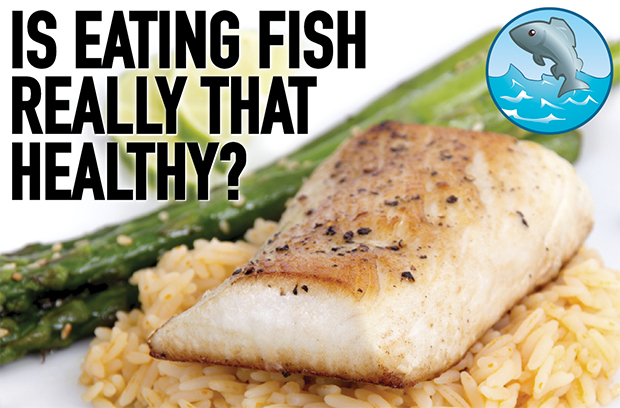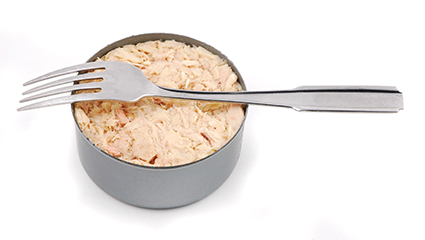Go fish: Is eating fish really that healthy?

Fish is a popular food choice among health and fitness advocates because it’s high in complete protein and essential fatty acids. But eating too much fish—and too much of the wrong types of fish—can actually do more harm to your health than good! There are a few really bad toxins that can accumulate in fish: dioxins and polychlorinated biphenyls (PCBs) and mercury.
Dioxins and PCBs are toxic chemicals that occur in the environment and accumulate in our food chain. More specifically, they accumulate in the fat of animals. Fish are the major dietary sources of dioxins and PCBs, especially fish caught in contaminated lakes or rivers. Levels of dioxins and PCBs found in fish will vary with the region and type of fish native to that region. If you eat locally caught fish, check for local advisories. In the USA, you can visit the Environmental Protection Agency. In Canada, simply Google “Canada fishing advisories” and your search will turn up helpful government webpages.
 In general, bottom-feeding fish (such as striped bass, bluefish, or sea trout) and larger predators (such as adult largemouth bass, lake trout, or walleye) caught in contaminated waters contain higher levels of dioxins and PCBs. Farmed fish that are fed ground-up fish as food have been found to be higher in PCBs than wild-caught fish. Long-term exposure to dioxins and PCBs has been shown to cause negative effects on the nervous, immune, endocrine, and reproductive systems, and they may also cause cancer.
In general, bottom-feeding fish (such as striped bass, bluefish, or sea trout) and larger predators (such as adult largemouth bass, lake trout, or walleye) caught in contaminated waters contain higher levels of dioxins and PCBs. Farmed fish that are fed ground-up fish as food have been found to be higher in PCBs than wild-caught fish. Long-term exposure to dioxins and PCBs has been shown to cause negative effects on the nervous, immune, endocrine, and reproductive systems, and they may also cause cancer.
Mercury is the other major toxin that’s of concern when eating fish. Eating too much high-mercury fish too often can raise the level of mercury in your body. This can cause permanent brain damage and can have toxic effects on the nervous, digestive, and immune systems and on the lungs, kidneys, skin, and eyes. Mercury is of particular concern for young children and pregnant and breast-feeding women because newborns and fetuses are more greatly affected by mercury. Large fish have more mercury for the simple reason that they usually live longer, allowing them more time to build up higher levels of mercury.
 According to the U.S. Food and Drug Administration, the fish that are highest in mercury and should be avoided altogether are king mackerel, marlin, orange roughy, shark, swordfish, tilefish (from the Gulf of Mexico), tuna (bigeye, ahi), bluefish, and grouper. Fish that are still quite high in mercury and shouldn’t be consumed regularly include bluefish, grouper, sea bass (Chilean), mackerel (Spanish, Gulf), croaker (white, Pacific), sablefish, perch (ocean), and tuna (canned albacore, yellowfin). Fish and shellfish that contain average amounts of mercury and that are okay to eat (albeit infrequently) include bass (saltwater, striped, black), buffalo fish, carp, cod (Alaskan), halibut, lobster, mahi mahi, monkfish, perch (freshwater), snapper, skate, tilefish (Atlantic), and tuna (canned chunk light).
According to the U.S. Food and Drug Administration, the fish that are highest in mercury and should be avoided altogether are king mackerel, marlin, orange roughy, shark, swordfish, tilefish (from the Gulf of Mexico), tuna (bigeye, ahi), bluefish, and grouper. Fish that are still quite high in mercury and shouldn’t be consumed regularly include bluefish, grouper, sea bass (Chilean), mackerel (Spanish, Gulf), croaker (white, Pacific), sablefish, perch (ocean), and tuna (canned albacore, yellowfin). Fish and shellfish that contain average amounts of mercury and that are okay to eat (albeit infrequently) include bass (saltwater, striped, black), buffalo fish, carp, cod (Alaskan), halibut, lobster, mahi mahi, monkfish, perch (freshwater), snapper, skate, tilefish (Atlantic), and tuna (canned chunk light).
The fish and shellfish that generally contain the lowest levels of mercury include anchovies, catfish, clam, crab, crawfish, croaker (Atlantic), flounder, haddock, hake, herring, mackerel (North Atlantic, chub), mullet, oyster, pollock, salmon, sardine, scallop, shrimp, sole, squid, tilapia, trout, and whitefish.
Follow Don Gauvreau @SupplementGodfather
Get articles like this one delivered to your email each month by signing up for Muscle Insider’s mailing list. Just click here.

